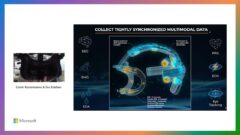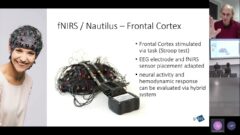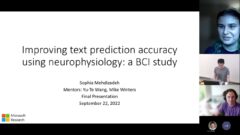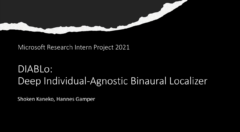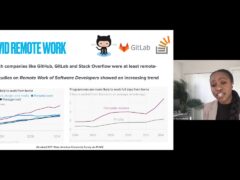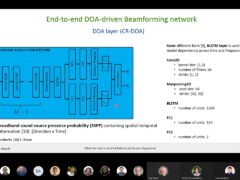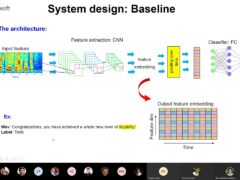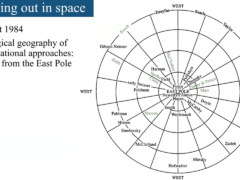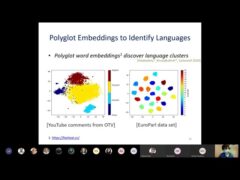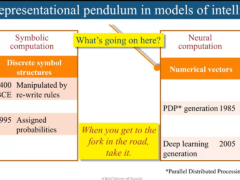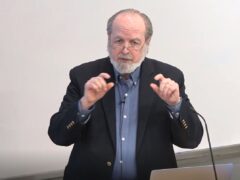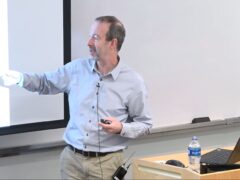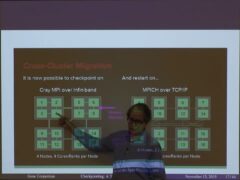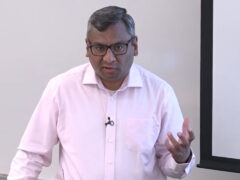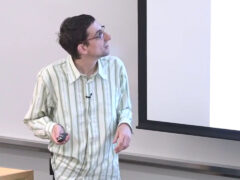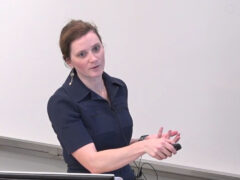Tensor Decompositions for Learning Hidden Variable Models
In many applications, we face the challenge of modeling the interactions between multiple observations. A popular and successful approach in machine learning and AI is to hypothesize the existence of certain latent (or hidden) causes which help to explain the correlations in the observed data. The (unsupervised) learning problem is to accurately estimate a model with only samples of the observed data. For example, in document modeling, we may wish to characterize the correlational structure of the “bag of words” in documents. Here, a standard model is to posit that documents are about a few topics (the hidden variables) and that each active topic determines the occurrence of words in the document. The learning problem is, using only the observed words in the documents (and not the hidden topics), to estimate the topic probability vectors (i.e. discover the strength by which words tend to appear under different topcis). In practice, a broad class of latent variable models is most often fit with either local search heuristics (such as the EM algorithm) or sampling based approaches.
This talk will discuss how generalizations of standard linear algebra tools (e.g. spectral methods) to tensors provide provable and efficient estimation methods for various latent variable models (under appropriate assumptions), including mixtures of Gaussians models, hidden Markov models, topic models, latent Dirichlet allocation, latent parse tree models (PCFGs and dependency parsers), and models for communities in social networks. The talk will also briefly discuss how matrix and tensor decomposition methods can be used for the structure learning problem of determining both the existence of certain hidden causes and the underlying graphical structure between these hidden causes and the observed variables.
Speaker Details
I am a new member of Microsoft Research New England, a new lab in Cambridge, MA. Previously, I was an associate professor at the Department of Statistics University of Pennsylvania (from 2010-2012), and I was an assistant professor at the Toyota Technological Institute at Chicago. Before this, I did a postdoc in the Computer and Information Science department at the University of Pennsylvania under the supervision of Michael Kearns. I completed my PhD at the Gatsby Unit where my advisor was Peter Dayan. Before Gatsby, I was an undergraduate at Caltech where I did my BS in physics
- Series:
- Microsoft Research Talks
- Date:
- Speakers:
- Sham Kakade
- Affiliation:
- MSR NE
-
-
Jeff Running
-

Sham Kakade
Sr. Principal Researcher
-
Series: Microsoft Research Talks
-
-
-
-
Galea: The Bridge Between Mixed Reality and Neurotechnology
Speakers:- Eva Esteban,
- Conor Russomanno
-
Current and Future Application of BCIs
Speakers:- Christoph Guger
-
Challenges in Evolving a Successful Database Product (SQL Server) to a Cloud Service (SQL Azure)
Speakers:- Hanuma Kodavalla,
- Phil Bernstein
-
Improving text prediction accuracy using neurophysiology
Speakers:- Sophia Mehdizadeh
-
-
DIABLo: a Deep Individual-Agnostic Binaural Localizer
Speakers:- Shoken Kaneko
-
-
Recent Efforts Towards Efficient And Scalable Neural Waveform Coding
Speakers:- Kai Zhen
-
-
Audio-based Toxic Language Detection
Speakers:- Midia Yousefi
-
-
From SqueezeNet to SqueezeBERT: Developing Efficient Deep Neural Networks
Speakers:- Sujeeth Bharadwaj
-
Hope Speech and Help Speech: Surfacing Positivity Amidst Hate
Speakers:- Monojit Choudhury
-
-
-
-
-
'F' to 'A' on the N.Y. Regents Science Exams: An Overview of the Aristo Project
Speakers:- Peter Clark
-
Checkpointing the Un-checkpointable: the Split-Process Approach for MPI and Formal Verification
Speakers:- Gene Cooperman
-
Learning Structured Models for Safe Robot Control
Speakers:- Ashish Kapoor
-
-




